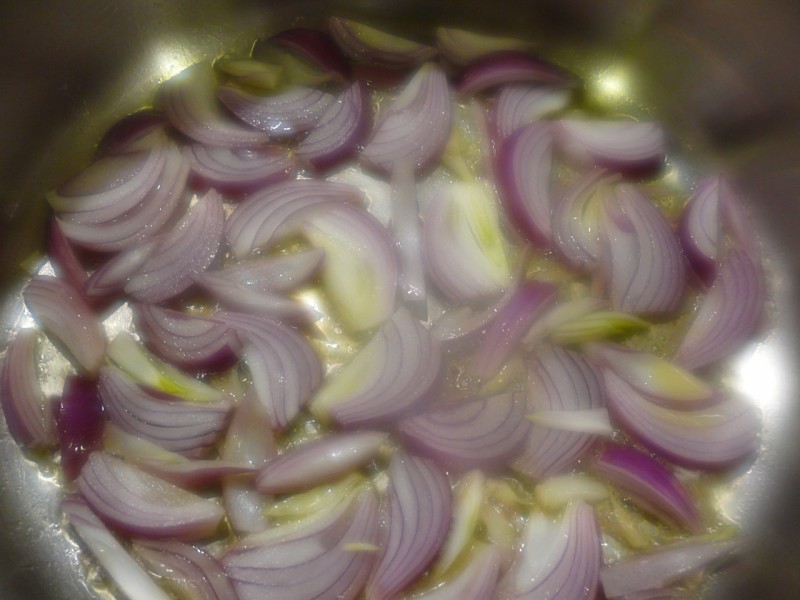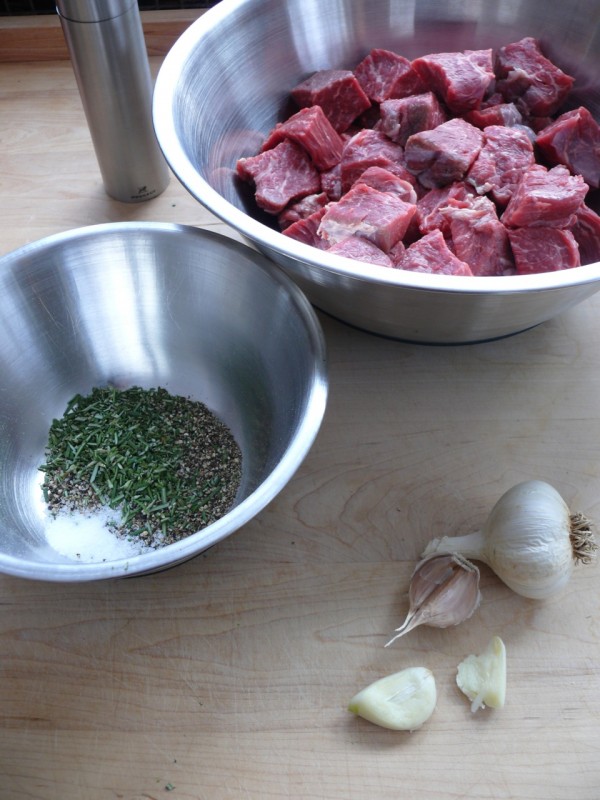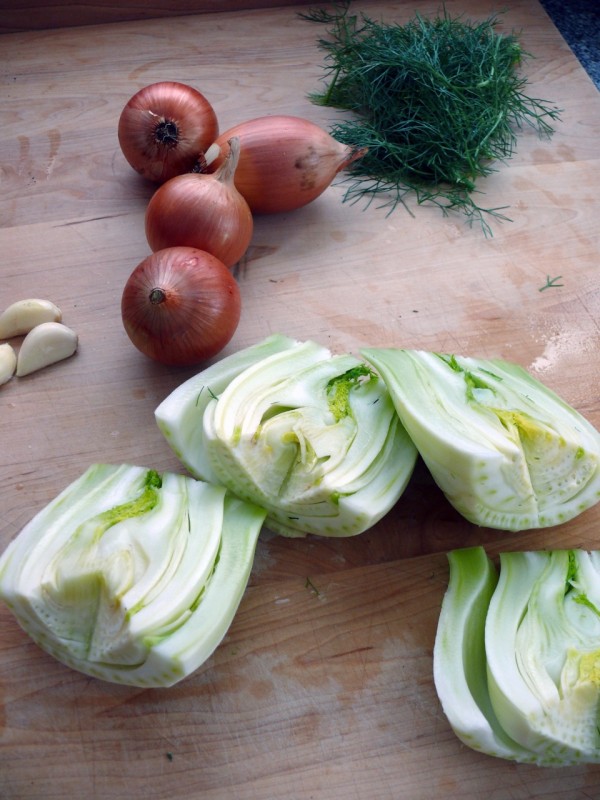Has this ever happened to you? It’s Friday evening, the end of a long, hard week. That morning you’d grabbed some meat from the freezer to thaw for dinner—let’s say bone-in chicken breasts. On the way home from work, you picked up some broccoli, a ripe red bell pepper, some crimini mushrooms, and a handful of pea greens. You figure you’ll bone the breasts and whip up a simple stir-fry. Your imagination starts wandering to seasonings—garlic, soy sauce, toasted sesame oil, and red chilies.
Now your partner arrives home, likewise thoroughly exhausted, and declares, before the briefcase hits the floor: “I’ve been thinking about that Brunello all day.”
Brunello and stir-fry? You thought maybe Riesling or Gewürztraminer, and now your sweetie wants to open an aromatic Tuscan red that has pronounced acidity, ripe fruit character, and moderate but not entirely demure tannins.
You’re a kind soul and happy to honor the craving. But as the cook, where do you go from here?
In another recent article about wine and food pairing, I worked from the vantage point of trying to select the best wine to pair with any given food. But here the situation is reversed: you’ve got a wine picked out and now need some tricks to prepare the food so it’s more friendly with that wine.
One of the most common recommendations is to cook with the wine you’ll serve with the food. You can use it as a marinating, braising, or simmering liquid, or simply deglaze with it to create a pan sauce. It’s a useful tip, but often isn’t practicable, like when you have only one bottle of that special (and expensive) Brunello.
Instead, you need some preparation tricks to make the flavors of the dish dance with the flavors, texture, and acidity of the wine. So, below are further recommendations for marrying foods with wine, derived from chefs, wine professionals, and from my own experience in learning to match my cooking to that night’s bottle.
It’s About Balance
 To my palate, the best dining experiences strike a balance of high, medium, and low flavor notes. High notes are contributed by acidity, freshness, spiciness, and bright aromatics. Medium notes are the primary flavors of the food—whatever makes blueberries taste like blueberries and salmon taste like salmon; its essential aromatic and textural profile. Low notes are the dark, rich, astringent, or deeply savory flavors underneath all these.
To my palate, the best dining experiences strike a balance of high, medium, and low flavor notes. High notes are contributed by acidity, freshness, spiciness, and bright aromatics. Medium notes are the primary flavors of the food—whatever makes blueberries taste like blueberries and salmon taste like salmon; its essential aromatic and textural profile. Low notes are the dark, rich, astringent, or deeply savory flavors underneath all these.
Any one item on your plate might have more of one than the other, but the whole should be, well, holistic: your seared (low note) tuna (primary flavor, medium note) might be served with a lemon-caper butter (high note from the lemon, low note from the butter), while the accompanying vegetables and grains add points along that continuum.
When you add wine to the mix, or indeed any new element, things get a little more complex. Well-made wines tend to have integrated primary fruit flavors, reverberant low notes from tannins and aging, and bright top notes from acidity.
Your job as a cook is to ensure that the elements both on the plate and in the glass play with well together and create a dining experience that excites all parts of your palate.
Just as winemakers seek balance in wine, no one element should dominate and eclipse all others. “My focus is never on ‘taming’ something,” says Viviane Bauquet-Farre, a chef whose specialty is seasonal vegetables, “but rather on balancing it.”
Temper Acidic Foods
Acidity is a key factor in the mix, because one of the surest ways to flatten out a wine is to serve it with a very acidic food. Eric Maczko, a certified sommelier and the executive chef at Round Pond Estate winery, cautions that “Your wine should be the most acidic thing in front of you—your food’s acid shouldn’t eclipse your wine’s acidity. If it does, then the wine seems flabby and weak, and fails to cleanse the palate,” adding, “We drink wine between bites of food to do just that: to cleanse our palates.”
This is why acidic foods like tomatoes, lemon, vinegar, and fresh goat cheese are traditionally served with wines with pronounced acidity, such as Chianti, Riesling, Pinot Gris, or Sauvignon Blanc.
Thankfully, cooks can modify acidic foods to allow them to pair with a wider range of wines. These techniques for the most part don’t actually alter the pH of the food, but simply modify our perceptions, tricking our palates into believing the food is less acidic than it is. Below are some favorite tips:
Add fat. Swirl a little butter or cream into a tomato sauce, or serve it with grated Parmigiano-Reggiano. This adds a bottom note to the acidic top note, and will coat your tongue to minimize the effect of the tangy acidity.
Add sugar. This is an old trick, but must be handled lightly, as you don’t want to end up with food that’s perceptibly sweet, because that can push the wine in another direction—toward astringency. Bauquet-Farre adds just a drop of honey or maple syrup to a lemony vinaigrette. Like fat, sugar doesn’t alter the food’s acidity, but it does mellow the perception of its tanginess.
Use a wine- or grape-based acid in place of cider vinegar or lemon juice. French cooks use verjus, the unfermented juice of partially ripened grapes, to tie a dish’s acidic component into the primary grape flavors in the wine. A white wine reduction, or a gastrique made with white grape juice, works similarly. Vincotto, a reduction of unfermented grape must, does double-duty by offering the grape flavor tie-in plus added sweetness. Ditto aged balsamic vinegar.
Avoid canned tomatoes. These are often processed with added citric acid to lower the pH even further to prevent growth of spoilage organisms. “Start with vine-ripened tomatoes,” advises Bauquet-Farre, “then simmer the sauce slowly to bring out their sweetness.” Fresh tomatoes have a higher sugar content and no added acids.
Add salt. Although pure sodium chloride (NaCl) is chemically neutral, unrefined sea salt, which has a higher alkaline mineral content, does very slightly raise the pH of a solution, making it less acidic, says salt expert Aaron Eckburg of Go Lb. Salt, a premium salt provider based in Phoenix, Arizona.
However, the most significant effect isn’t chemical but perceptual: salt heightens the perception of sweetness, reduces the impression of both bitterness and acidity, and creates a fuller, more luscious mouth feel. This is why salt is a critical ingredient in all cooking, from sweet to savory.
Most of the recommendations for balancing acidic foods also hold for balancing spicy foods, which can seem far too hot when served with a full-bodied wine. Adding a little cream, ghee, or cheese, making judicious use of salt, or enhancing the sauce’s sweetness will tame the heat and allow the food to play with bigger red wines. It still might not be a perfect pairing, but it will be better.
Add Heft to Lightweight Foods
 Raw foods, blanched vegetables, light meats, and fish are often best paired with crisp, light-bodied whites or rosés. But what if you need to serve your salad or crudité platter with a red wine, which might make them seem watery and flavorless? What if you need to serve that chicken with a medium-bodied red?
Raw foods, blanched vegetables, light meats, and fish are often best paired with crisp, light-bodied whites or rosés. But what if you need to serve your salad or crudité platter with a red wine, which might make them seem watery and flavorless? What if you need to serve that chicken with a medium-bodied red?
Vegetable expert Bauquet-Farre offers a few hints. While a basic lemony vinaigrette should be served with a crisp white, tossing the same salad with a vinaigrette made with garlic, mustard, and balsamic vinegar lets you pair it with a red with medium body and good acidity. Now substitute a truffle or roasted-shallot vinaigrette and you can pair the salad with a full-bodied white.
I’ve also found that by using that more hefty vinaigrette and adding grilled Portobello mushrooms, bacon, blue cheese, nuts, or other rich ingredients to a salad, and perhaps ratcheting back the dressing’s acidity, I can pair it with even more substantial reds. Here you’re building the bottom notes to keep it in balance with the body of the wine. A few other tips:
Add savory flavors (umami elements). Black olive paste, anchovy paste, aged balsamic vinegar, soy sauce, and grated aged cheeses add savoriness, complexity, and depth to fresh vegetables. This tricks palate into thinking the food itself has been aged or cooked. Likewise, roast or grill lighter meats and fish (preferably with the skin on) to add depth and savoriness.
Add salt. See above. Sprinkle vegetables with sea salt or use salty condiments like feta cheese, olives, or bacon (which is both savory and salty). The salt will enhance the flavors while also minimizing the impression of the tannins.
Use flavorful oils. Fruity olive oil, truffle oil, herb-infused oil, and roasted garlic oil give raw and lightly cooked foods more substance in your mouth and add flavor dimensions.
Or, cook your vegetables instead. Instead of serving your vegetables raw, cook them to deepen their flavors and add caramel notes. Toss with a little oil and salt, then roast or grill—a technique you can use with a wide range of vegetables, from asparagus to tomatoes, beets to Brussels sprouts. Or, braise starchier vegetables like carrots in a little stock, then quickly cook off the liquid to turn them into a savory side dish.
Balance Richer Foods
Just as lean or acidic foods need a little richness to pair with heftier wines, richer foods may need a refreshing element to pair with lighter wines.
Chef Michel Cornu, director of cuisine and hospitality at Raymond Vineyards and Boisset Family Estates in St. Helena, California, cautions that taste is personal, making preferences “very controversial!,” but he remains broad-minded. “For instance, people have always associated foie gras with a late harvest wine, but myself, I find it too sirupeux and prefer a more acidic wine.” I tend to agree: too syrupy. Indeed, the first time I encountered foie, the chef had dressed it with tangy sautéed grapes and paired it with a dry table wine.
Add acidity and cleansing elements. A squeeze of citrus, a dab of fruit relish, a cool raita, or even just a sprinkling of chopped chives with richer foods will help create a bridge to the wine’s acidity and refresh your palate before you sip.
Sear richer meats, but keep them rare. Searing meats, or roasting them at a very high temperature, creates a crust on the outside through a process called Maillard browning. This is somewhat like caramelization, but involves proteins as well as sugars, and it creates a wide range of compounds that add flavor complexity and bottom notes. Just make sure to keep the inside of the meat rare to medium-rare, as overcooked meat can taste metallic when it meets an astringent red wine. Rare red meat pairs better with tannins.
Create Flavor Bridges
Here, instead of reining in the food’s acidity (top note) or adding savoriness (bottom note), you’re finding harmonious middle notes shared by both food and wine. This is harder when you’re unfamiliar with the wine in the bottle, although if it’s opened early enough in the cooking cycle, its aromas and a few quick sips can guide your hand during cooking.
Add bridge seasonings. Maczko notes a few common affinities: Sauvignon Blanc with chives, tarragon, parsley, and lemon thyme; Cabernet Sauvignon with thyme, rosemary, sage, mint, and bay. I like herbes de Provence with Southern Rhône reds, fennel with Piemontese reds, and black pepper with Grenache. Adding these herbs to the food will connect with, and also to some extent mute, the same flavors in the wine, but will create a powerful flavor tie-in.
Add bridge ingredients. Some ingredients, like mushrooms, tomatoes, nuts, and fruits, can be added to the cuisine to link it to the wine’s primary flavors. This was what I had in mind recently when I served a rich venison phyllo strudel with a few pomegranate seeds scattered on top. The juicy, astringent fruit was a direct echo of the flavors of the Syrah I poured with it.
• • •
Back to our heroes. Now, how would you solve the conundrum of the chicken and Brunello? Here’s what I would do:
Leave the breasts whole, rubbing the skins with a mixture of thyme, fennel seed, garlic, salt, and pepper. These herbs are used a lot in Tuscan cooking and are good partners for the flavors of Sangiovese. Place the breasts in a shallow roasting pan, then toss quartered crimini mushrooms on top. Drizzle everything with a little olive oil and roast in a hot oven until browned and cooked to an internal temperature of 165°F.
Once the meat is out of the oven and resting, toss the broccoli with a tiny bit of oil and salt and dry roast it in a hot cast iron pan until tinged brown and slightly caramelized. Add strips of the fresh red pepper toward the end. This adds a charred smokiness to the slightly bitter broccoli while preserving the sweetness of the pepper.
Plate the chicken pieces and mushrooms, spooning the pan juices on top. Add the sautéed vegetables alongside and scatter a few pea greens around, drizzling both with just a tad of aged balsamic vinegar.
I’ve added savoriness (roasting, browning), richness (oils), herbaceousness (thyme, fennel, garlic, pea greens), earthiness (mushrooms), acidity (balsamic vinegar), and smokiness (roasting) to the palette of flavors, which contributed depth, top notes, and flavor bridges to tie the food and wine together.
The meal would be just as easy to prepare as a stir-fry. And my sweetie would get his well-deserved Brunello.
How would you solve this particular pairing problem? What’s your favorite trick for making your cooking more wine-friendly?

